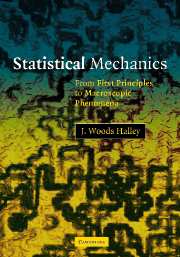Book contents
- Frontmatter
- Contents
- Preface
- Introduction
- Part I Foundations of equilibrium statistical mechanics
- 1 The classical distribution function
- 2 Quantum mechanical density matrix
- 3 Thermodynamics
- 4 Semiclassical limit
- Part II States of matter in equilibrium statistical physics
- Part III Dynamics
- Appendix: Solutions to selected problems
- Index
2 - Quantum mechanical density matrix
Published online by Cambridge University Press: 05 June 2012
- Frontmatter
- Contents
- Preface
- Introduction
- Part I Foundations of equilibrium statistical mechanics
- 1 The classical distribution function
- 2 Quantum mechanical density matrix
- 3 Thermodynamics
- 4 Semiclassical limit
- Part II States of matter in equilibrium statistical physics
- Part III Dynamics
- Appendix: Solutions to selected problems
- Index
Summary
For systems which obey quantum mechanics, the formulation of the problem of treating large numbers of particles is, of course, somewhat different than it is for classical systems. The microscopic description of the system is provided by a wave function which (in the absence of spin) is a function of the classical coordinates {qi}. The mathematical model is provided by a Hamiltonian operator H which is often obtained from the corresponding classical Hamiltonian by the replacement pi → (ħ/i)(∂/∂qi). In other cases the form of the Hamiltonian operator is simply postulated. The microscopic dynamics are provided by the Schrödinger equation i ħ(∂Ψ/∂t) = HΨ which requires as initial condition the knowledge of the wave function Ψ({qi}, t) at some initial time t0. (Boundary conditions on Ψ({qi}, t) must be specified as part of the description of the model as well.) The results of experiments in quantum mechanics are characterized by operators, usually obtained, like the Hamiltonian, from their classical forms and termed observables. Operators associated with observables must be Hermitian. In general, the various operators corresponding to observables do not commute with one another. It is possible to find sets of commuting operators whose mutual eigenstates span the Hilbert space in which the wave function is confined by the Schrödinger equation and the boundary conditions. A set of such (time independent) eigenstates, termed ψν(q), is a basis for the Hilbert space.
- Type
- Chapter
- Information
- Statistical MechanicsFrom First Principles to Macroscopic Phenomena, pp. 27 - 36Publisher: Cambridge University PressPrint publication year: 2006



